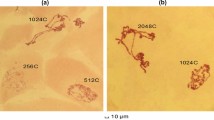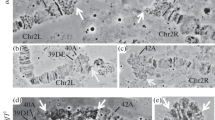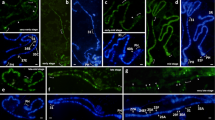Abstract
Heterozygotes for the dominant temperature sensitive mutant DTS-3 of Drosophila melanogaster die as third instar larvae when grown at 29° C. These larvae have grossly hypertrophied ring glands due to the growth of the prothoracic gland cells. The nuclei of the prothoracic glands possess polytene chromosomes which are as large as those of salivary gland nuclei. The banding pattern of these chromosomes is similar, if not identical, to that of salivary gland polytene chromosomes but the puffing patterns are quite different. The salivary gland chromosomes of DTS-3/+ larvae also hypertrophy and lack the normal ecdysone induced puffs. Both the prothoracic gland and salivary gland chromosomes of these mutant larvae react to ecdysone in vitro by the induction of similar puffs.
Similar content being viewed by others
References
Aggarwal, S.K., King, R.C.: A comparative study of the ring glands from wild type and l(2)gl mutant Drosophila melanogaster. J. Morph. 129, 171–200 (1969)
Ashburner, M.: Patterns of puffing activity in the salivary gland chromosomes of Drosophila. V. Responses to environmental treatments. Chromosoma (Berl.) 31, 356–376 (1969)
Ashburner, M.: Sequential Gene activation by ecdysone in polytene chromosomes of Drosophila melanogaster. I Dependence upon ecdysone concentration. Develop. Biol. 39, 141–157 (1973)
Ashburner, M., Richards G.: The role of ecdysone in the control of gene activity in the polytene chromosomes of Drosophila. In: Insect development (P.A. Lawrence, ed.), pp. 203–225. Oxford: Blackwell 1976
Beermann, W.: Chromomerenkonstanz bei Chironomus. Naturwissenschaften 37, 543–544 (1950)
Berendes, H.D.: The induction of changes in chromosomal activity in different polytene types of cell in Drosophila hydei. Develop. Biol. 11, 371–384 (1965)
Berendes, H.D.: Gene activities in the malpighian tubules of Drosophila hydei at different developmental stages. J. exp. Zool. 162, 209–218 (1966)
Bodenstein, D.: The postembryonic development of Drosophila In: The biology of Drosophila (M. Demerec, ed.). New York: J. Wiley 1950
Bollenbacher, W.E., Goodman W., Vedeckis W.V., Gilbert L.I.: The in vitro synthesis and secretion of α-ecdysone by the ring glands of the fly, Sarcophaga bullata. Steroids 27, 309–324 (1976)
Borst, D.W., Bollenbacher, W.E., O'Connor, J.D., King, D.S., Fristrom, J.W.: Ecdysone levels during metamorphosis of Drosophila melanogaster. Develop. Biol. 39, 308–316 (1974)
Breugel, F.M.A. van, Bos, M.J.: Some notes on differential chromosome activity in Drosophila. Genetica ('s-Gravenhage) 40, 359–378 (1969)
Gateff, E., Schneiderman H.A.: Developmental capacities of benign and malignant neoplasms of Drosophila. Wilhelm Roux' Archiv 176, 23–67 (1974)
Hadorn E.: An accelerating effect of normal “ring glands” on puparium formation in lethal larvae of Drosophila melanogaster. Proc. nat. Acad. Sci. (Wash.) 23, 478–484 (1937)
Hadorn, E., Gehring, W., Staub, M.: Extensives Größenwachstum larvaler Speicheldrüsenchromosomen von Drosophila melanogaster im Adultmilieu. Experientia (Basel) 19, 530–531 (1963)
Hodgetts, R.B., Sage B., O'Connor, J.D.: Ecdysone titers during postembryonic development of Drosophila melanogaster. Develop. Biol. 60, 310–317 (1977)
Holden, J.J., Suzuki, D.T.: Temperature sensitive mutations in Drosophila. XII. The genetic and developmental effects of dominant lethals on chromosome 3. Genetics 73, 445–458 (1973)
Karlson, P., Hanser, G.: Uber die Wirking des Puparisierungshormons bei des Wildforms und der Mutant lgl von Drosophila melanogaster. Z. Naturforsch. 7b, 80–83 (1952)
Kaufman, T.C.: Characterization of 3 new alleles of the giant locus of Drosophila melanogaster. Genetics 71, s28-s29 (Abstract) (1972)
Korge, G.: Larval saliva in Drosophila melanogaster: Production, composition, and relationship to chromosome puffs. Develop. Biol. 58, 339–355 (1977)
Korochkina, L.S., Nazarova, N.K.: Comparative characteristics of the puffing pattern and the endocrine system in an Oregon laboratory stock and in l(2)gl Drosophila melanogaster mutants different in the time of their death. Chromosoma (Berl.) 62, 175–190 (1977)
Pavan, C., Breuer, M.E.: Polytene chromosomes in different tissues of Rhynchosciara. J. Hered. 43, 151–157 (1952)
Richards, G.P.: Sequential gene activation by ecdysone in polytene chromosomes of Drosophila melanogaster. IV The Mid-prepupal period. Develop. Biol. 54, 256–263 (1976a)
Richards, G.P.: The in vitro induction of puffing in salivary glands of the mutant l(2)gl of Drosophila melanogaster by ecdysone. Wilhelm Roux' Archiv 179, 339–348 (1976b)
Scharrer, B., Hadorn E.: The structure of the ring gland (corpus allatum) in normal and lethal larvae of Drosophila melanogaster. Proc. nat. Acad. Sci. (Wash.) 24, 236–242 (1938)
Welch, R.M.: A developmental analysis of the lethal mutant 1(2)gl of Drosophila melanogaster based on cytophotometric determination of nuclear desoxyribonucleic acid (DNA) content. Genetics 42, 544–559 (1957)
Wigglesworth, V.B.: The breakdown of the thoracic gland in an adult insect, Rhodnius prolixus. J. exp. Biol. 32, 485–491 (1955)
Yoon, J.G., Richardson, R., Wheeler M.R.: A technique for improving salivary chromosome preparations. Experientia (Basel) 29, 639–641 (1973)
Zhimulev, I.F., Belyaeva, E.S., Lychev, V.A.: Comparative study of the function of polytene chromosome in laboratory stocks of Drosophila melanogaster and the l(3)tl mutant (lethal tumorous larvae). II. Changes of banding pattern and transcriptional activity in the salivary chromosomes of l(3)tl. Chromosoma (Berl.) 55, 121–136 (1976)
Author information
Authors and Affiliations
Rights and permissions
About this article
Cite this article
Holden, J.J., Ashburner, M. Patterns of puffing activity in the salivary gland chromosomes of Drosophila . Chromosoma 68, 205–227 (1978). https://doi.org/10.1007/BF00335417
Received:
Accepted:
Issue Date:
DOI: https://doi.org/10.1007/BF00335417




